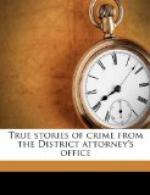Then the door in the back of the court room opened and James Parker was led to the bar, where in the presence of the jury he pleaded guilty to the forgery of the very signature for which his wife was standing trial. (Kauser check, Fig. 6.) He was then sworn as a witness, took the stand and testified that he had written all the forged signatures to the checks, including the signatures upon “the Peabody sheet.”
The District Attorney found himself in an embarrassing position. If Parker was the forger, why not challenge him to write the forged signatures upon the witness stand and thus to prove his alleged capacity for so doing? The obvious objection to this was that Parker, in anticipation of this test, had probably been practicing the signature in the Tombs for months. On the other hand if the District Attorney did not challenge him to write the signatures, the defense would argue that he was afraid to do so, and that as Parker had sworn himself to be the forger it was not incumbent upon the defense to prove it further—that that was a matter for cross examination.
With considerable hesitation the prosecuting attorney asked Parker to write the Kauser signature, which was the one set forth in the indictment charging the forgery, and after much backing and filling on the part of the witness, who ingeniously complained that he was in a bad nervous condition owing to lack of morphine, in consequence of which his hand trembled and he was in no condition to write forgeries, the latter took his pen and managed to make a very fair copy of the Kauser signature from memory, good enough in fact to warrant a jury in forming the conclusion that he was in fact the forger. (Fig. 7.) This closed the case.
The defense claimed that it was clear that James Parker was the forger, since he had admitted it in open court, pleaded guilty to the indictment and proved that he had the capacity. The prosecution, upon the other hand, argued that the evidence was conclusive that the defendant herself was the writer of the check. The whole thing boiled down to whether or not the jury was going to believe that Mrs. Parker had written “the Peabody sheet” in the presence of the detective, when her husband claimed that, with the exception of Mabel’s signature, he had done it himself and carelessly left the paper in his desk in the room.
[Illustration: FIG. 7.—Parker’s copy of the signature of Alice Kauser, made in court in an attempt to shield his wife.]
The prosecuting attorney was at his wits’ end for an argument to meet the fact that Parker had written a sample forgery of the Kauser signature before the very eyes of the jury. He found it at last in an offer on his own part in open court during his “summing up” to write for the jury from memory a better forgery of the Kauser signature than that written by Parker himself, and thus to show how simple a matter it was to learn to do so. He had taken up his pen and was about to give a sample




